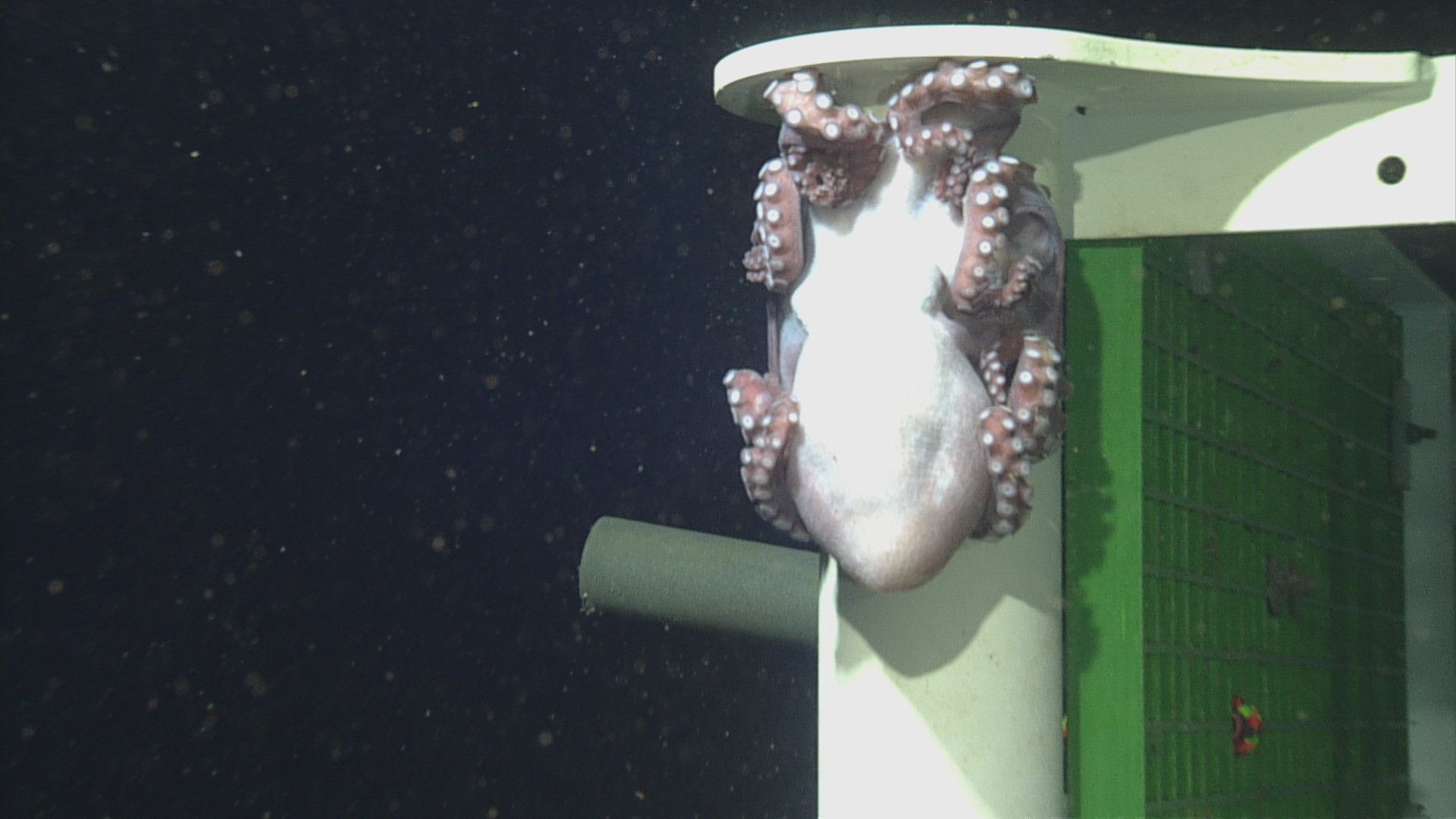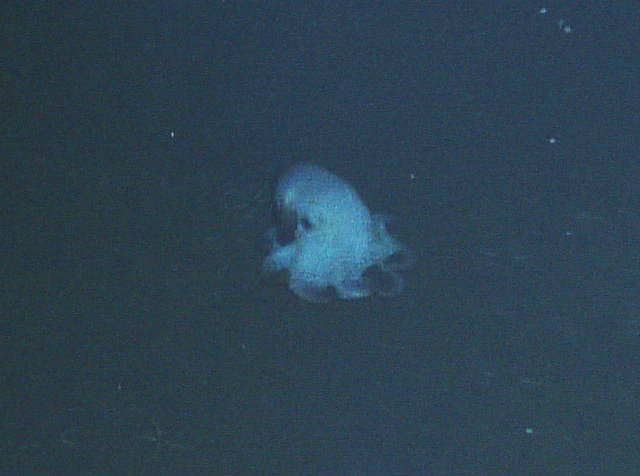Image Archive





























A Giant Pacific Octopus we encountered while exploring Southern Hydrate Ridge. Credit: M. Vardaro, University of Washington, V24.

A disgruntled Giant Pacific Octopus had to vacate its cozy node house as we conducted operations at the Oregon Offshore site. Credit: UW/NSF-OOI/WHOI, J2-1626, V24.

Screen shot of an octopus, seen through the incredible resolution of Jason’s main camera. Credit: E. Perkins, University of Washington, V24.

Graneledone octopus on a lava flow in the International District hydrothermal field. Credit: UW/NSF-OOI/WHOI; J2-1615.V24.

White, gray and purple Deep Sea Octopus – Muusoctopus sp. walking along the sea floor. Credit: UW/NSF-OOI/WHOI; J2-1609; V24.

Octopus with webbed arms and a fringed mantle after moving from old to new seafloor node at the OR Offshore site at 600m depth offshore of Newport, OR. Credit: UW/NSF-OOI/WHOI, Dive J2-1249, V20

Octopus with webbed arms and a fringed mantle moving from old to new seafloor node at the OR Offshore site at 600m depth offshore of Newport, OR. Credit: UW/NSF-OOI/WHOI, Dive J2-1249, V20

Giant Pacific Octopus curled up in a seafloor cable container at the Oregon Offshore (600 m) site. Credit: UW/NSF-OOI/WHOI, Dive J2-1249, V20

A Giant Pacific Octopus claimed this cable-laying platform near primary node PN1D, near the Oregon Shelf (80 m) site. Credit: UW/NSF-OOI/WHOI, J2-1529, V23.

A deep-sea octopus (possibly Muusoctopus?) seen at Slope Base during the Shallow Profiler EOM anchor inspection. Two anemones are attached to the nearby cable. Credit: NSF-OOI/UW/CSSF, Dive R2256, V22

A deep-sea octopus (possibly Muusoctopus?) seen at Slope Base during the Shallow Profiler EOM anchor inspection. Photo credit: NSF-OOI/UW/CSSF, Dive R2256, V22

A deep-sea purple octopus (Graneledone boreopacifica) seen during a survey on the Eastern flank of Axial Caldera. Credit: NSF-OOI/UW/CSSF, Dive R2243, V22

A deep-sea purple octopus (Graneledone boreopacifica) seen during a survey on the Eastern flank of Axial Caldera. Credit: NSF-OOI/UW/CSSF, Dive R2243, V22

A deep-sea purple octopus (Graneledone boreopacifica) sitting on a jumbled lava flow at the ASHES vent field in Axial Caldera. Credit: NSF-OOI/UW/CSSF, Dive R2240, V22

A warty, deep-sea purple octopus (Graneledone boreopacifica) hiding beneath a ledge on a lava pillar at Axial Seamount. Credit: NSF-OOI/UW/CSSF, Dive R2213, V22

A Graneledone octopus hides among bizarre lava flow structures near International District vent field in Axial Caldera. Credit: UW/NSF-OOI/CSSF, Dive R2213, V22.

A warty, deep-sea purple octopus (Graneledone boreopacifica) sitting on a lava flow at Axial Seamount. Credit: NSF-OOI/UW/CSSF, Dive R2213, V22

This squished-looking Flapjack octopus (Opisthoteuthis sp.) was seen at Southern Hydrate Ridge during a site survey in 2022. Credit: UW/NSF-OOI/CSSF, ROPOS Dive R2228, V22.

Deep-sea octopus (Muusoctopus sp.) at Axial Base 2600 m; Photo Credit: UW/NSF-OOI/WHOI, V19

A Graneledone octopus peeking at Jason around the side of the Axial Base HPIES instrument. Photo Credit: UW/NSF-OOI/WHOI; V19

An octopus at 9500 ft beneath the oceans' surface finds a home by the leg of one of the Cabled Array junction boxes at the Slope Base site. Credit: UW/NSF-OOI/WHOI, V18.

An octopus clings to a mooring chain at ~9500 ft water depth near the toe of the Cascadia Margine off of Newport, Oregon. UW/NSF-OOI/CSSF; V15.

A well-camouflaged octopus encountered during a survey at the Oregon Shelf site (80 meters water depth). Credit: UW/NSF-OOI/CSSF, ROPOS Dive R1756, V14.

A deep-sea octopus (possibly a Muusoctopus), clinging to the leg of the medium power junction box MJ01A at Slope Base. It may be brooding eggs, and they can guard their eggs for over four years, longer than any known animal. Credit: UW/NSF-OOI/CSSF, ROPOS Dive R1751, V14.

An octopus (likely Muusoctopus sp.) smiles for the ROPOS camera at Primary Node 3A at the base of Axial Seamount. Credit: UW/NSF-OOI/CSSF, V14.

An octopus hanging out next to primary node PN3A at Axial Base, 2600 meters deep. Credit: UW/NSF-OOI/CSSF, ROPOS Dive R1742, V14.

An octopus hanging out near primary node PN3A at Axial Base, 2600 meters deep. Credit: UW/NSF-OOI/CSSF,ROPOS Dive 1742, V14.

A dumbo octopus (Grimpoteuthis) at the Axial Base site at 2600 m water depth. Identified by cephalopod experts Stephanie Bush (MBARI) and Mike Vecchione (Smithsonian) Credit: UW/NSF-OOI/CSSF, Dive R1739, V14.
- Anemone
- Animal
- Arthropod
- ASHES
- Axial
- Axial Base
- Axial Biology
- Axial Caldera
- Bacteria
- Basalt Lava
- BEP
- Biofouling
- biolgoy
- Biology
- Camds
- Camera
- Camhd
- Central Caldera
- Ciliates
- Cnidaria
- Coastal Biology
- Crab
- Deep Profiler Mooring
- Dive Highlights
- Eastern Caldera
- Echinoderms
- Endurance Array
- Engineering Team
- ENLIGHTEN 10
- Exploratorium
- Fish
- Geology
- HD Camera
- HPIES
- Hydrate Ridge
- Hydrates
- Hydrophone
- Hydrothermal Vents
- Illustration
- Inshore 80 Meters
- Instrument
- International District
- J-BOX
- Jason
- Jellyfish
- Junction Box
- K12
- Lava
- Mollusk
- Moorings
- Nodes
- Nudibranch
- Octopus
- OOI
- Oregon Offshore
- Oregon Offshore 600 m
- Oregon Shelf
- Oregon Slope Base
- People
- PN1B
- PN1D
- Polychaetes
- PPSDN
- Primary Node
- RASFL
- ROCLS
- ROPOS
- ROPOS Dives
- ROV Team
- RV Revelle
- RV Sikuliaq
- RV Thompson
- Salp
- Sample
- SC13
- Science Team
- Sea Cucumber
- Sea Star
- Sea Urchin
- Seafloor
- Seismometer
- Sensors
- Shallow Profiler Mooring
- Shark
- Shipboard
- Shore Station
- Slope Base
- Smoker
- Soft Coral
- Southern Hydrate Ridge
- Sponge
- Squid
- Students
- Students & Guest Participants
- Tmpsf
- Tubeworms
- VISIONS 11 Leg 1
- VISIONS 11 Leg 2
- VISIONS 11 Viewers
- VISIONS 13
- VISIONS 14
- VISIONS 15
- VISIONS 16
- VISIONS 17
- VISIONS 18
- VISIONS 20
- VISIONS 22
- VISIONS 23
- Visualization
